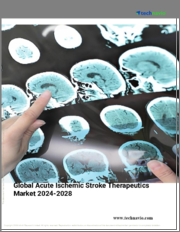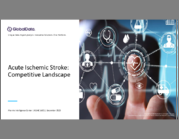
|
시장보고서
상품코드
1796142
급성 허혈성 뇌졸중 치료제 시장 규모, 점유율, 성장 분석 : 진단별, 약제 클래스별, 지역별 - 산업 예측(2025-2032년)Acute Ischemic Stroke Therapeutics Market Size, Share, and Growth Analysis, By Diagnosis (CT, MRI), By Drug Class (Tissue Plasminogen Activator, Anticoagulant), By Region - Industry Forecast 2025-2032 |
||||||
세계의 급성 허혈성 뇌졸중 치료제 시장 규모는 2023년에 84억 달러로 평가되며, 예측 기간(2025-2032년)에 CAGR 8.7%로 성장하며, 2024년 91억 3,000만 달러에서 2032년에는 178억 달러로 성장할 전망입니다.
세계의 급성 허혈성 뇌졸중 치료제 시장은 뇌혈관 질환의 유병률 증가와 첨단 혈전용해제 및 기계적 혈전제거술의 채택 증가로 인해 크게 성장하고 있습니다. 이 시장을 촉진하는 주요 요인은 고혈압, 당뇨병, 심방세동과 같은 생활습관 관련 위험요인의 발생률이 증가하고 있으며, 이러한 위험요인은 뇌졸중 위험을 증가시켜 적시에 개입할 필요성을 증가시키고 있습니다. 그러나 특히 의료 혜택이 부족한 지역에서는 높은 치료비와 부족한 진단 인프라가 접근성을 저해하고 있으며, 치료 대상이 한정된 좁은 치료 창구도 문제점으로 지적되고 있습니다. 북미는 강력한 인지도, 탄탄한 의료 시스템, 유리한 상환 관행에 힘입어 시장을 독점하고 있습니다. 한편, 뇌졸중 치료와 AI 진단에 대한 지속적인 투자는 이 분야의 성장을 더욱 촉진할 것으로 기대됩니다.
목차
서론
- 조사의 목적
- 조사 범위
- 정의
조사 방법
- 정보 조달
- 2차와 1차 데이터 방법
- 시장 규모 예측
- 시장의 전제조건과 제한
개요
- 세계 시장 전망
- 공급과 수요 동향 분석
- 부문별 기회 분석
시장 역학과 전망
- 시장 개요
- 시장 규모
- 시장 역학
- 촉진요인과 기회
- 억제요인과 과제
- Porter의 산업 분석
주요 시장 인사이트
- 주요 성공 요인
- 경쟁의 정도
- 주요 투자 기회
- 시장 에코시스템
- 시장의 매력 지수(2024년)
- PESTEL 분석
- 거시경제 지표
- 밸류체인 분석
- 가격 분석
- 사례 연구
- 고객 구매 행동 분석
급성 허혈성 뇌졸중 치료제 시장 규모 : 진단별 & CAGR(2025-2032)
- 시장 개요
- CT
- MRI
- 경동맥 초음파 검사
- 뇌혈관조영검사
급성 허혈성 뇌졸중 치료제 시장 규모 : 약제 클래스별 & CAGR(2025-2032)
- 시장 개요
- 조직 플라스미노겐 활성화인자
- 항응고제
- 항혈소판제
- 강압제
급성 허혈성 뇌졸중 치료제 시장 규모 : 지역별 & CAGR(2025-2032)
- 북미
- 미국
- 캐나다
- 유럽
- 독일
- 스페인
- 프랑스
- 영국
- 이탈리아
- 기타 유럽 지역
- 아시아태평양
- 중국
- 인도
- 일본
- 한국
- 기타 아시아태평양
- 라틴아메리카
- 브라질
- 기타 라틴아메리카 지역
- 중동 및 아프리카
- GCC 국가
- 남아프리카공화국
- 기타 중동 및 아프리카
경쟁 정보
- 상위 5사의 비교
- 주요 기업의 시장 포지셔닝(2024년)
- 주요 시장 기업이 채택한 전략
- 최근 시장 동향
- 기업의 시장 점유율 분석(2024년)
- 주요 기업의 기업 개요
- 기업의 상세
- 제품 포트폴리오 분석
- 기업의 부문별 점유율 분석
- 매출의 전년대비 비교(2022-2024년)
주요 기업 개요
- Amgen Inc.(United States)
- Pfizer Inc.(United States)
- Sanofi S.A.(France)
- Novartis International AG(Switzerland)
- Johnson & Johnson(United States)
- Merck & Co., Inc.(United States)
- GlaxoSmithKline plc(United Kingdom)
- AbbVie Inc.(United States)
- Bayer AG(Germany)
- Bristol Myers Squibb(United States)
- AstraZeneca plc(United Kingdom)
- Eli Lilly and Company(United States)
- Takeda Pharmaceutical Company Limited(Japan)
결론과 제안
KSA 25.08.29Global Acute Ischemic Stroke Therapeutics Market size was valued at USD 8.4 billion in 2023 and is poised to grow from USD 9.13 billion in 2024 to USD 17.8 billion by 2032, growing at a CAGR of 8.7% during the forecast period (2025-2032).
The global market for acute ischemic stroke therapeutics is witnessing significant growth, driven by the increasing prevalence of cerebrovascular diseases and the heightened adoption of advanced thrombolytics and mechanical thrombectomy techniques. A major factor fueling this market is the rising incidence of lifestyle-related risk factors such as hypertension, diabetes, and atrial fibrillation, which elevate stroke risk and heighten the necessity for timely interventions. However, challenges persist due to the narrow therapeutic window that limits treatment eligibility, especially in underserved areas, alongside high treatment costs and inadequate diagnostic infrastructure that hinder accessibility. North America dominates the market, supported by strong awareness, robust healthcare systems, and favorable reimbursement practices, while ongoing investments in stroke care and AI diagnostics promise to further propel growth in this sector.
Top-down and bottom-up approaches were used to estimate and validate the size of the Global Acute Ischemic Stroke Therapeutics market and to estimate the size of various other dependent submarkets. The research methodology used to estimate the market size includes the following details: The key players in the market were identified through secondary research, and their market shares in the respective regions were determined through primary and secondary research. This entire procedure includes the study of the annual and financial reports of the top market players and extensive interviews for key insights from industry leaders such as CEOs, VPs, directors, and marketing executives. All percentage shares split, and breakdowns were determined using secondary sources and verified through Primary sources. All possible parameters that affect the markets covered in this research study have been accounted for, viewed in extensive detail, verified through primary research, and analyzed to get the final quantitative and qualitative data.
Global Acute Ischemic Stroke Therapeutics Market Segments Analysis
Global Acute Ischemic Stroke Therapeutics Market is segmented by Diagnosis, Drug Class and region. Based on Diagnosis, the market is segmented into CT, MRI, Carotid Ultrasound and Cerebral Angiography. Based on Drug Class, the market is segmented into Tissue Plasminogen Activator, Anticoagulant, Antiplatelet and Antihypertensive. Based on region, the market is segmented into North America, Europe, Asia Pacific, Latin America and Middle East & Africa.
Driver of the Global Acute Ischemic Stroke Therapeutics Market
The global acute ischemic stroke therapeutics market is significantly influenced by the rising prevalence of stroke, especially within aging demographics. As strokes represent a leading cause of disability and mortality worldwide, the demand for effective treatments has surged. The increasing life expectancy across various populations has heightened the vulnerability to strokes, resulting in a greater need for advanced therapeutics such as thrombolytics, neuroprotective agents, and mechanical thrombectomy techniques. This growing awareness and need for timely and effective intervention in stroke management continue to propel the development and availability of innovative therapeutic solutions in the market.
Restraints in the Global Acute Ischemic Stroke Therapeutics Market
A significant challenge in addressing ischemic stroke lies in the limited treatment window, usually within a few hours for effective thrombolysis. Delays in recognizing symptoms and reaching medical facilities often result in missed chances for treatment. This issue is further compounded in many low- and middle-income areas, where limited access to advanced imaging technologies and a shortage of trained stroke specialists can lead to delays in diagnosis and intervention. Such barriers ultimately restrict the availability and implementation of therapeutic options, hindering the overall management of acute ischemic stroke in affected populations.
Market Trends of the Global Acute Ischemic Stroke Therapeutics Market
The Global Acute Ischemic Stroke Therapeutics market is witnessing a transformative trend driven by the integration of personalized medicine and Artificial Intelligence (AI). By leveraging AI to accurately assess clot locations, predict treatment responses, and inform therapeutic decisions, healthcare providers are enhancing the efficacy of acute stroke interventions. Coupled with advancements in genomics and biomarkers, this trend is fostering more targeted treatment approaches, resulting in optimized patient outcomes. Hospitals that implement AI-assisted stroke triage systems are demonstrating significant improvements in crucial metrics, such as reduced door-to-needle times, which is further propelling interest and investment in innovative stroke care solutions.
Table of Contents
Introduction
- Objectives of the Study
- Scope of the Report
- Definitions
Research Methodology
- Information Procurement
- Secondary & Primary Data Methods
- Market Size Estimation
- Market Assumptions & Limitations
Executive Summary
- Global Market Outlook
- Supply & Demand Trend Analysis
- Segmental Opportunity Analysis
Market Dynamics & Outlook
- Market Overview
- Market Size
- Market Dynamics
- Drivers & Opportunities
- Restraints & Challenges
- Porters Analysis
- Competitive rivalry
- Threat of substitute
- Bargaining power of buyers
- Threat of new entrants
- Bargaining power of suppliers
Key Market Insights
- Key Success Factors
- Degree of Competition
- Top Investment Pockets
- Market Ecosystem
- Market Attractiveness Index, 2024
- PESTEL Analysis
- Macro-Economic Indicators
- Value Chain Analysis
- Pricing Analysis
- Case Studies
- Customer Buying Behavior Analysis
Global Acute Ischemic Stroke Therapeutics Market Size by Diagnosis & CAGR (2025-2032)
- Market Overview
- CT
- MRI
- Carotid Ultrasound
- Cerebral Angiography
Global Acute Ischemic Stroke Therapeutics Market Size by Drug Class & CAGR (2025-2032)
- Market Overview
- Tissue Plasminogen Activator
- Anticoagulant
- Antiplatelet
- Antihypertensive
Global Acute Ischemic Stroke Therapeutics Market Size & CAGR (2025-2032)
- North America (Diagnosis, Drug Class)
- US
- Canada
- Europe (Diagnosis, Drug Class)
- Germany
- Spain
- France
- UK
- Italy
- Rest of Europe
- Asia Pacific (Diagnosis, Drug Class)
- China
- India
- Japan
- South Korea
- Rest of Asia-Pacific
- Latin America (Diagnosis, Drug Class)
- Brazil
- Rest of Latin America
- Middle East & Africa (Diagnosis, Drug Class)
- GCC Countries
- South Africa
- Rest of Middle East & Africa
Competitive Intelligence
- Top 5 Player Comparison
- Market Positioning of Key Players, 2024
- Strategies Adopted by Key Market Players
- Recent Developments in the Market
- Company Market Share Analysis, 2024
- Company Profiles of All Key Players
- Company Details
- Product Portfolio Analysis
- Company's Segmental Share Analysis
- Revenue Y-O-Y Comparison (2022-2024)
Key Company Profiles
- Amgen Inc. (United States)
- Company Overview
- Business Segment Overview
- Financial Updates
- Key Developments
- Pfizer Inc. (United States)
- Company Overview
- Business Segment Overview
- Financial Updates
- Key Developments
- Sanofi S.A. (France)
- Company Overview
- Business Segment Overview
- Financial Updates
- Key Developments
- Novartis International AG (Switzerland)
- Company Overview
- Business Segment Overview
- Financial Updates
- Key Developments
- Johnson & Johnson (United States)
- Company Overview
- Business Segment Overview
- Financial Updates
- Key Developments
- Merck & Co., Inc. (United States)
- Company Overview
- Business Segment Overview
- Financial Updates
- Key Developments
- GlaxoSmithKline plc (United Kingdom)
- Company Overview
- Business Segment Overview
- Financial Updates
- Key Developments
- AbbVie Inc. (United States)
- Company Overview
- Business Segment Overview
- Financial Updates
- Key Developments
- Bayer AG (Germany)
- Company Overview
- Business Segment Overview
- Financial Updates
- Key Developments
- Bristol Myers Squibb (United States)
- Company Overview
- Business Segment Overview
- Financial Updates
- Key Developments
- AstraZeneca plc (United Kingdom)
- Company Overview
- Business Segment Overview
- Financial Updates
- Key Developments
- Eli Lilly and Company (United States)
- Company Overview
- Business Segment Overview
- Financial Updates
- Key Developments
- Takeda Pharmaceutical Company Limited (Japan)
- Company Overview
- Business Segment Overview
- Financial Updates
- Key Developments



















